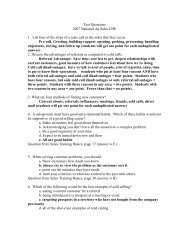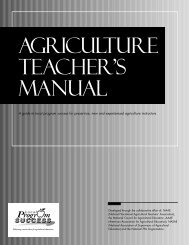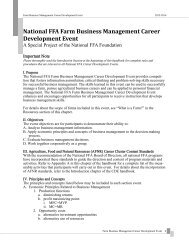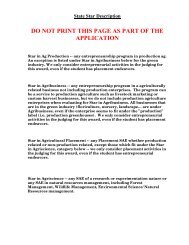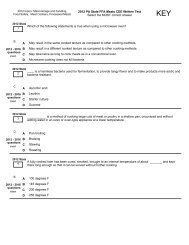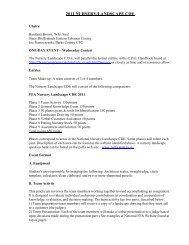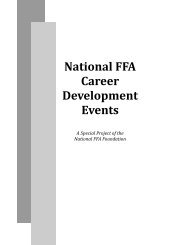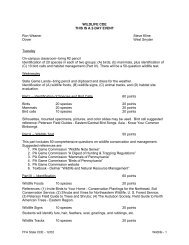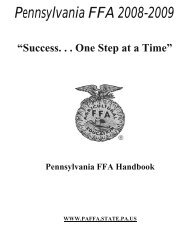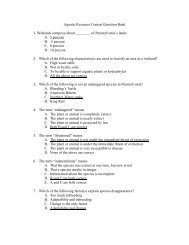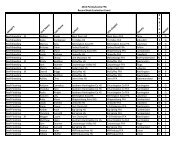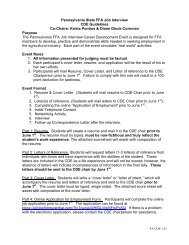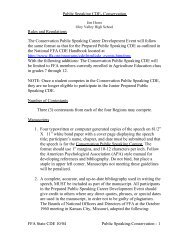Aquatics resources c.d.e. this is a 2-day event - Pa FFA
Aquatics resources c.d.e. this is a 2-day event - Pa FFA
Aquatics resources c.d.e. this is a 2-day event - Pa FFA
Create successful ePaper yourself
Turn your PDF publications into a flip-book with our unique Google optimized e-Paper software.
÷ means divide<br />
AQUATICS RESOURCES C.D.E.<br />
THIS IS A 2-DAY EVENT<br />
Bruce Stajnrajh<br />
Garden Spot HS<br />
Gretchen Dingman<br />
Tri-Valley HS<br />
Websites: PA Department of Conservation and Natural Resources: http://www.dcnr.state.pa.us/index.aspx<br />
PA Envirothon: http://www.envirothonpa.org<br />
PA Game Comm<strong>is</strong>sion: http://www.pgc.state.pa.us<br />
PA F<strong>is</strong>h & Boat Comm<strong>is</strong>sion: http://www.f<strong>is</strong>h.state.pa.us<br />
Tues<strong>day</strong><br />
Identification of ten species in each of four groups: (1) f<strong>is</strong>h, (2) reptiles and amphibians, (3) birds<br />
and mammals, (4) equipment used in aquatic study, (5) aquatic insects, and (6) aquatic plants.<br />
Plus, there will be a 50-question test including questions on aquatic <strong>resources</strong> and their<br />
management.<br />
Wednes<strong>day</strong><br />
<strong>Pa</strong>rticipation in three of the practicums l<strong>is</strong>ted below and any remaining identification <strong>event</strong>s from<br />
Tues<strong>day</strong>.<br />
<strong>Pa</strong>rt I - Written Test (200 points)<br />
Th<strong>is</strong> section includes 50 comprehensive questions on Limnology (stream ecology),<br />
groundwater, ecology of aquatic species, management practices, F<strong>is</strong>h Comm<strong>is</strong>sion laws, etc.<br />
Suggested references are:<br />
• PFBC “Sport F<strong>is</strong>hes of Pennsylvania”<br />
• PFBC “Pennsylvania F<strong>is</strong>hes”<br />
• PFBC “Pennsylvania Reptiles and Amphibians”<br />
• PFBC “Summary of F<strong>is</strong>hing Regulations and Laws” - current year<br />
• PFBC “Planning and Management of Small Ponds for F<strong>is</strong>hing”<br />
• PFBC “Endangered and Threatened Species of Pennsylvania”<br />
• PFBC “Acid Precipitation”<br />
• PFBC “Water Pollution”<br />
• PFBC “Wetlands: Natural and Necessary”<br />
• PSU, Cooperative Extension “Groundwater and Agriculture in Pennsylvania<br />
• NRCS “Conservation and the Water Cycle<br />
• NRCS “What <strong>is</strong> a Watershed”<br />
<strong>Pa</strong>rt II - Identification of Aquatic Species, Insects and Plants (300 points)<br />
Th<strong>is</strong> section will include 10 of each:<br />
• F<strong>is</strong>h<br />
• Reptiles and Amphibians<br />
• Birds and Mammals<br />
• Equipment<br />
• Aquatic Insects<br />
• Aquatic Plants<br />
<strong>FFA</strong> State C.D.E. - 02/02 <strong>Aquatics</strong> Resources - 1
÷ means divide<br />
Mounted, preserved, or live specimens, body parts, pictures, and/or colored slides may be used<br />
for identification in the part of the <strong>event</strong>. The following <strong>is</strong> a suggested study reference l<strong>is</strong>t:<br />
F<strong>is</strong>h<br />
Reptiles &<br />
Amphibians<br />
Birds & Mammals<br />
Equipment<br />
Insect References<br />
Plant References<br />
PFBC wall chart: “Sport f<strong>is</strong>hes of PA”<br />
PFBC wall chart: “PA F<strong>is</strong>hes”<br />
PFBC wall chart: “PA Reptiles and Amphibians”<br />
Assorted field guides to reptiles and amphibians<br />
PGC wall charts<br />
PGC “Mammals of PA,”<br />
PGC “Birds of PA”<br />
Assorted field guides to birds and mammals<br />
Forestry Suppliers Inc. Catalog<br />
P. O. Box 8397<br />
Jackson, MS 39284-8397<br />
1-800-647-5368<br />
SVNC: Biotic Index Activity guide included in the practicum<br />
section of <strong>th<strong>is</strong></strong> <strong>event</strong>, “Insects at Susquehanna Valley Nature<br />
Center”<br />
DCNR: “A Guide to Common Freshwater Animals”<br />
PSU Cooperative Extension: “Aquatic Plants--Management and<br />
Control in Pennsylvania”<br />
PFBC: “Aquatic Plant Control”<br />
PSU Cooperative Extension: “Aquatic Plants--A Guide to<br />
Identification and Control in Pennsylvania”<br />
<strong>Pa</strong>rt III - Practicums: Problem Solving/Analys<strong>is</strong> (150 Points)<br />
Practicum activities will be held on site (local pond/stream) and transportation <strong>is</strong> provided.<br />
<strong>Pa</strong>rticipants should bring: pencil, calculator, clipboard, 50’ measuring tape, watch (with second<br />
hand), waders and/or clothing to wade in stream, hand lens, and biotic sampling/collecting<br />
equipment (i.e., sieve, seine screen, white plastic pan, tweezers, etc.). All other supplies and<br />
equipment will be supplied.<br />
Th<strong>is</strong> part will cons<strong>is</strong>t of three of the following hands-on activities:<br />
1. Water testing (using Hach/Lamotte test kit):<br />
- d<strong>is</strong>solved oxygen,<br />
- temperature,<br />
- pH,<br />
- turbidity<br />
2. Stream flow and volume of water in a stream/pond<br />
3. Calculate biotic index<br />
4. Determining watershed boundaries<br />
5. Pond management<br />
<strong>FFA</strong> State C.D.E. - 02/02 <strong>Aquatics</strong> Resources - 2
÷ means divide<br />
AQUATIC RESOURCE C.D.E.<br />
MASTER SCORE SHEET<br />
Name<br />
School<br />
Student No.<br />
Score<br />
Scoring: Maximum Points Total<br />
Score Earned Score<br />
<strong>Pa</strong>rt I -- Written Test (200 pts.)<br />
(50 questions at 4 points each)<br />
Total Score <strong>Pa</strong>rt I 200 __________ __________<br />
<strong>Pa</strong>rt II -- Identification (300 pts.)<br />
(200 spp. Ea.; 5 points each)<br />
A. F<strong>is</strong>h (50 pts.) __________<br />
B. Reptiles & Amphibians (50 pts.) __________<br />
C. Birds & Mammals (50 pts.) __________<br />
D. Equipment (50 pts.) __________<br />
E. Aquatic Insects (50 pts.) __________<br />
F. Aquatic Plants (50 pts.) __________<br />
Total Score <strong>Pa</strong>rt II 300 __________<br />
<strong>Pa</strong>rt III -- Practicums (150 pts.)<br />
(3 at 50 pts. Each chosen from below)<br />
Practicum 1: D.O., Temp., pH<br />
Practicum 2: Stream Flow<br />
Practicum 3: Biotic Index<br />
Practicum 4: Determining Water-<br />
Shed Boundaries<br />
Practicum 5: Pond Management<br />
__________<br />
__________<br />
__________<br />
__________<br />
__________<br />
Total Score <strong>Pa</strong>rt III 150 __________<br />
Maximum Total Possible 650<br />
FINAL TOTAL SCORE<br />
__________<br />
<strong>FFA</strong> State C.D.E. - 02/02 <strong>Aquatics</strong> Resources - 3
÷ means divide<br />
AQUATIC RESOURCE C.D.E.<br />
GENERAL KNOWLEDGE EXAM (200 PTS.)<br />
Name<br />
School<br />
Student No.<br />
Score<br />
1. _____<br />
2. _____<br />
3. _____<br />
4. _____<br />
5. _____<br />
6. _____<br />
7. _____<br />
8. _____<br />
9. _____<br />
10. _____<br />
11. _____<br />
12. _____<br />
13. _____<br />
14. _____<br />
15. _____<br />
16. _____<br />
17. _____<br />
18. _____<br />
19. _____<br />
20. _____<br />
21. _____<br />
22. _____<br />
23. _____<br />
24. _____<br />
25. _____<br />
26. _____<br />
27. _____<br />
28. _____<br />
29. _____<br />
30. _____<br />
31. _____<br />
32. _____<br />
33. _____<br />
34. _____<br />
35. _____<br />
36. _____<br />
37. _____<br />
38. _____<br />
39. _____<br />
40. _____<br />
41. _____<br />
42. _____<br />
43. _____<br />
44. _____<br />
45. _____<br />
46. _____<br />
47. _____<br />
48. _____<br />
49. _____<br />
50. _____<br />
<strong>FFA</strong> State C.D.E. - 02/02 <strong>Aquatics</strong> Resources - 4
÷ means divide<br />
IDENTIFICATION OF AQUATIC SPECIES -- ANSWER SHEET<br />
Name<br />
School<br />
Student No.<br />
Score<br />
Place the number of the species from your master l<strong>is</strong>t to the number of the slide/specimen you<br />
think identifies that particular species.<br />
A. F<strong>is</strong>h C. Birds/Mammals E. Aquatic Insects<br />
(50 points) (Use (50 points) (Use (50 points)<br />
YELLOW master sheet) BLUE master sheet) GREEN master sheet)<br />
1. _____________ 1. _____________ 1. _____________<br />
2. _____________ 2. _____________ 2. _____________<br />
3. _____________ 3. _____________ 3. _____________<br />
4. _____________ 4. _____________ 4. _____________<br />
5. _____________ 5. _____________ 5. _____________<br />
6. _____________ 6. _____________ 6. _____________<br />
7. _____________ 7. _____________ 7. _____________<br />
8. _____________ 8. _____________ 8. _____________<br />
9. _____________ 9. _____________ 9. _____________<br />
10. _____________ 10. _____________ 10. _____________<br />
B. Reptiles/Amphibians D. EQUIPMENT F. Aquatic Plants<br />
(50 points) (Use (50 points) (Use (50 points) (Use<br />
YELLOW master sheet) BLUE master sheet) GREEN master sheet)<br />
1. _____________ 1. _____________ 1. _____________<br />
2. _____________ 2. _____________ 2. _____________<br />
3. _____________ 3. _____________ 3. _____________<br />
4. _____________ 4. _____________ 4. _____________<br />
5. _____________ 5. _____________ 5. _____________<br />
6. _____________ 6. _____________ 6. _____________<br />
7. _____________ 7. _____________ 7. _____________<br />
8. _____________ 8. _____________ 8. _____________<br />
9. _____________ 9. _____________ 9. _____________<br />
10. _____________ 10. _____________ 10. _____________<br />
<strong>FFA</strong> State C.D.E. - 02/02 <strong>Aquatics</strong> Resources - 5
÷ means divide<br />
IDENTIFICATION OF AQUATIC SPECIES<br />
A. IDENTIFICATION OF FISH<br />
Name<br />
School<br />
Student No.<br />
Score<br />
Basses (True)<br />
_____ Hybrid Striped Bass<br />
_____ Striped Bass<br />
_____ White Bass<br />
Catf<strong>is</strong>hes<br />
_____ Brown Bullhead Catf<strong>is</strong>h<br />
_____ Channel Catf<strong>is</strong>h<br />
_____ Yellow Bullhead Catf<strong>is</strong>h<br />
Eels<br />
_____ American Eel<br />
Herrings<br />
_____ American Shad<br />
_____ Gizzard Shad<br />
Minnows<br />
_____ Blacknose Dace<br />
_____ Bluntnose Minnow<br />
_____ Carp<br />
_____ Central Stoneroller<br />
_____ Common Shiner<br />
_____ Creek Chub<br />
_____ Cutlips Minnow<br />
_____ Fathead Minnow<br />
_____ Fallf<strong>is</strong>h<br />
_____ Golden Minnow<br />
_____ Longnose Dace<br />
Perches<br />
_____ Darter<br />
_____ Sauger<br />
_____ Walleye<br />
_____ Yellow Perch<br />
Pikes<br />
_____ Chain Pickerel<br />
_____ Muskellunge<br />
_____ Northern Pike<br />
Suckers<br />
_____ Northern Hogsucker<br />
_____ White Sucker<br />
Sunf<strong>is</strong>hes<br />
_____ Black Crappie<br />
_____ Bluegill<br />
_____ Green Sunf<strong>is</strong>h<br />
_____ Largemouth Bass<br />
_____ Pumpkinseed<br />
_____ Redbreast Sunf<strong>is</strong>h<br />
_____ Rockbass<br />
_____ Smallmouth Bass<br />
_____ White Crappie<br />
Trouts/Salmon<br />
_____ Brook Trout<br />
_____ Brown Trout<br />
_____ Coho Salmon<br />
_____ Lake Trout<br />
_____ <strong>Pa</strong>lomino Trout<br />
_____ Rainbow Trout<br />
_____ Tilapia<br />
Number Correct x 5 = SCORE __________<br />
<strong>FFA</strong> State C.D.E. - 02/02 <strong>Aquatics</strong> Resources - 6
Means divide<br />
IDENTIFICATION OF AQUATIC SPECIES<br />
B. IDENTIFICATION OF REPTILES AND AMPHIBIANS<br />
Name ___________________________________________ Student No. _____________<br />
School __________________________________________ Score __________________<br />
REPTILES<br />
Lizards<br />
_____ Broad head skink<br />
_____ Coal skink<br />
_____ Fence lizard<br />
_____ Five-lined skink<br />
Snakes<br />
_____ Black Racer<br />
_____ Black Rat<br />
_____ Brown<br />
_____ Copperhead<br />
_____ Corn<br />
_____ Cottonmouth<br />
_____ Eastern Worm<br />
_____ Garter<br />
_____ Hognose<br />
_____ Milk<br />
_____ Queen<br />
_____ Redbelly<br />
_____ Ribbon<br />
_____ Ringneck<br />
_____ Rough Green<br />
_____ Smooth Earth<br />
_____ Smooth Green<br />
_____ Timber Rattlesnake<br />
_____ Water<br />
Turtles<br />
_____ Box<br />
_____ Eastern Mud<br />
_____ Map<br />
_____ <strong>Pa</strong>inted<br />
_____ Red eared<br />
_____ Snapping<br />
_____ Spiny Softshell<br />
_____ Spotted<br />
_____ Wood<br />
Toads<br />
_____ American<br />
_____ Fowler’s<br />
AMPHIBIANS<br />
Frogs<br />
_____ Bullfrog<br />
_____ Gray/Green Treefrog<br />
_____ Green<br />
_____ Leopard<br />
_____ Pickerel<br />
_____ Spring Peeper<br />
_____ Wood<br />
Salamanders<br />
_____ Dusky<br />
_____ Four-toed<br />
_____ Hellbender<br />
_____ Jefferson<br />
_____ Longtail<br />
_____ Red<br />
_____ Redback<br />
_____ Red-spotted Newt<br />
_____ Slimy<br />
_____ Spotted<br />
_____ Spring<br />
_____ Two-lined<br />
Number Correct x 5 = SCORE _______<br />
<strong>FFA</strong> state C.D. E. – 7/04 Aquatic Resources - 7
Means divide<br />
IDENTIFICATION OF AQUATIC SPECIES<br />
C. IDENTIFICATION OF BIRDS AND MAMMALS<br />
Name ___________________________________________ Student No. _____________<br />
School __________________________________________ Score __________________<br />
BIRDS<br />
Birds of Prey<br />
_____ Bald Eagle<br />
_____ Marsh Hawk (N. Harrier)<br />
_____ Osprey<br />
Marsh and Water<br />
_____ Belted Kingf<strong>is</strong>her<br />
_____ Coot<br />
_____ Egret<br />
_____ Greenback Heron<br />
_____ Great Blue Heron<br />
_____ Herring Gull<br />
_____ Least Tern<br />
_____ Marsh Wren<br />
_____ Red-winged Blackbird<br />
_____ Ring-billed Gull<br />
_____ Snipe<br />
_____ Tree Swallow<br />
MAMMALS<br />
_____ Beaver<br />
_____ Black Bear<br />
_____ Mink<br />
_____ Mole<br />
_____ Mouse<br />
_____ Muskrat<br />
_____ Nutria<br />
_____ Otter<br />
_____ Raccoon<br />
_____ Shrew<br />
_____ Vole<br />
_____ White-tailed Deer<br />
Waterfowl<br />
_____ Black Duck<br />
_____ Blue-winged Teal<br />
_____ Canada Goose<br />
_____ Common Merganser<br />
_____ Green-winged Teal<br />
_____ Mallard Duck<br />
_____ Pintail Duck<br />
_____ Tundra Swan<br />
_____ Wood Duck<br />
Number Correct x 5 = SCORE _______<br />
<strong>FFA</strong> state C.D. E. – 7/04 Aquatic Resources - 8
Means divide<br />
IDENTIFICATION OF AQUATIC SPECIES<br />
D. IDENTIFICATION OF EQUIPMENT<br />
Name ___________________________________________ Student No. _____________<br />
School __________________________________________ Score __________________<br />
_____ Bottom-sampling dredge<br />
_____ Chemical Waste jug<br />
_____ Color Comparator<br />
_____ Conductivity Meter<br />
_____ D<strong>is</strong>solved oxygen water test kit / meter<br />
_____ F<strong>is</strong>h measuring board<br />
_____ GPS Locator<br />
_____ Hach kit for water quality<br />
_____ Hip boots<br />
_____ Kick net / aquatic net<br />
_____ Periphyton (multi-plate) sampler<br />
_____ pH meter<br />
_____ pH water test kit<br />
_____ Plankton net<br />
_____ refractormeter<br />
_____ Secchi d<strong>is</strong>k<br />
_____ Seine<br />
_____ Sieve<br />
_____ Stream bottom (surber) sampler<br />
_____ Topographic map<br />
_____ Turbidity Tube<br />
_____ Water sample bottle<br />
_____ Water sampler / Kemmerer Sampler<br />
_____ Water Thermometer<br />
Number Correct x 5 = SCORE _______<br />
<strong>FFA</strong> state C.D. E. – 7/04 Aquatic Resources - 9
Means divide<br />
IDENTIFICATION OF AQUATIC SPECIES<br />
E. IDENTIFICATION OF AQUATIC INSECTS<br />
Name ___________________________________________ Student No. _____________<br />
School __________________________________________ Score __________________<br />
Pollution Intolerant (Class I)<br />
_____ Cadd<strong>is</strong>fly<br />
_____ Freshwater clam<br />
_____ Hellgramite<br />
_____ Mayfly<br />
_____ Riffle Beetle<br />
_____ Stonefly<br />
_____ Waterpenny<br />
Facultative (Class II)<br />
_____ Aquatic Sowbug<br />
_____ Blackfly<br />
_____ Cranefly<br />
_____ Crayf<strong>is</strong>h<br />
_____ Damselfly<br />
_____ Dragonfly<br />
_____ Fingernail clam<br />
_____ Flatworm<br />
_____ Gill Snail<br />
_____ Horsefly<br />
Pollution Tolerant (Class III)<br />
_____ Air-breathing snail<br />
_____ Aquatic earthworm<br />
_____ Backswimmer<br />
_____ Freshwater shrimp<br />
_____ Leech<br />
_____ Limpet<br />
_____ Midge<br />
_____ Mosquito<br />
_____ Moth Fly<br />
_____ Rat-tailed Maggot<br />
_____ Scud-side Swimmer<br />
_____ Sea Lamprey<br />
_____ Water boatman<br />
_____ Water Strider<br />
_____ Whirligig Beetle<br />
_____ Zebra Mussel<br />
Number Correct x 5 = SCORE _______<br />
<strong>FFA</strong> state C.D. E. – 7/04 Aquatic Resources - 10
Means divide<br />
IDENTIFICATION OF AQUATIC SPECIES<br />
F. IDENTIFICATION OF AQUATIC PLANTS<br />
Name ___________________________________________ Student No. _____________<br />
School __________________________________________ Score __________________<br />
Emergents<br />
_____ Arrowhead<br />
_____ Cattail<br />
_____ Cinnamon Fern<br />
_____ Cinquefoil<br />
_____ Horsetail<br />
_____ Hydrilla<br />
_____ Jewelweed<br />
_____ Marsh Marigold<br />
_____ Pennyweed<br />
_____ Purple Loosestrife<br />
_____ Rushes<br />
_____ Sedges<br />
_____ Sensitive fern<br />
_____ Skunk cabbage<br />
_____ Water cress<br />
_____ Water Hemlock<br />
_____ Water Smartweed<br />
Floaters<br />
_____ Algae<br />
_____ Duckweed<br />
_____ Spatterdock<br />
_____ Watershield<br />
_____ WhiteWater Lily<br />
_____ Yellow water Lily<br />
Submergents<br />
_____ American (floating) Pondweed<br />
_____ Bladderwort<br />
_____ Common Elodea (waterweed)<br />
_____ Coontail<br />
_____ Curly Pondweed<br />
_____ Milfoil (water Milfoil)<br />
_____ Sago Pondweed<br />
Trees & Shrubs<br />
_____ Ash<br />
_____ Black Gum (tupelo)<br />
_____ Blueberry<br />
_____ Box Elder Maple<br />
_____ Elderberry<br />
_____ Elm<br />
_____ Hemlock<br />
_____ Honey Locust<br />
_____ Larch<br />
_____ Mimosa Tree<br />
_____ Rhododendron<br />
_____ Silver Maple<br />
_____ Speckled Alder<br />
_____ Spice Bush<br />
_____ Sycamore<br />
_____ Willow<br />
_____ Yellow Birch<br />
Number Correct x 5 = SCORE _______<br />
<strong>FFA</strong> state C.D. E. – 7/04 Aquatic Resources - 11
PART III: PRACTICUMS<br />
Name<br />
School<br />
Student No.<br />
Score<br />
1. Water Testing: D<strong>is</strong>solved Oxygen (D.O.), Temperature, and pH<br />
A. Using the test kit(s) and thermometer provided, perform the following water tests on the<br />
sample and record the results below:<br />
Test Results:<br />
D.O. __________<br />
Temp. ________<br />
B. Based on the D<strong>is</strong>solved Oxygen level you found, use the chart below to predict the<br />
major species of aquatic life supported in <strong>th<strong>is</strong></strong> water:<br />
D<strong>is</strong>solved Oxygen Requirements for Native F<strong>is</strong>h and Other Aquatic Life<br />
D.O. in parts per million<br />
Examples of Life<br />
or/milligrams per liter<br />
Cold-water organ<strong>is</strong>ms, including salmon and trout<br />
spawning, growth and well-being (cadd<strong>is</strong>flly, stonefly,<br />
mapfly)<br />
Warm-water organ<strong>is</strong>ms (including game f<strong>is</strong>h such as<br />
bass, crappie, cat f<strong>is</strong>h and carp) growth and wellbeing<br />
(some cadd<strong>is</strong>fly)<br />
6 ppm and above<br />
5 ppm and below<br />
C. Based on the Temperature you found, use the following chart to predict the major<br />
species of aquatic life supported in <strong>th<strong>is</strong></strong> water:<br />
Temperature Requirements for Native F<strong>is</strong>h and Other Aquatic Life<br />
Examples of Life<br />
Cold-water organ<strong>is</strong>ms, including salmon and trout,<br />
cadd<strong>is</strong>flly, stonefly, and mapfly nymphs<br />
Mayfly nymphs, cadd<strong>is</strong>fly larvae, water beetles, water<br />
striders<br />
Some plant life, some f<strong>is</strong>h d<strong>is</strong>eases, trout, stonefly<br />
nymps<br />
Much plant life, many f<strong>is</strong>h d<strong>is</strong>eases, bass, crappie,<br />
bluegill, catf<strong>is</strong>h and carp<br />
Temperature<br />
D. Based on both temperature and d<strong>is</strong>solved oxygen you found, use the following percent<br />
saturation chart to determine the percent saturation of your water sample with d<strong>is</strong>solved<br />
oxygen:<br />
Temperature conversion formulas:<br />
C = (F – 32) F = (C x 1.8) + 32<br />
1.8<br />
Percent Saturation __________<br />
E. Based on the pH you found, use the chart below to predict the major species of aquatic<br />
life supported in <strong>th<strong>is</strong></strong> water<br />
pH Ranges that Support Aquatic Life<br />
Most Acid Neutral Most Alkaline<br />
1 2 3 4 5 6 7 8 9 10 11 12 13 14<br />
Bacteria 1.0 13.0<br />
Plants (algae,<br />
rooted, etc.) 6.5 12.0<br />
Carp, suckers, catf<strong>is</strong>h,<br />
some insects 6.0 9.0<br />
Bass, crappie 6.5. 8.5<br />
Snails, clams,<br />
mussels 7.0 9.0<br />
Largest variety of<br />
animals (trout, mayflystonefly,<br />
cadd<strong>is</strong>flly) 6.5 7.5<br />
<strong>FFA</strong> State C.D.E. - 02/02 <strong>Aquatics</strong> Resources - 13
÷ means divide<br />
PART III: PRACTICUMS (continued)<br />
Name<br />
School<br />
Student No.<br />
Score<br />
2. Stream Flow<br />
For Stream<br />
A. Measure and mark a 100-foot d<strong>is</strong>tance along a straight section of your stream. If you<br />
can’t find a 100-foot section, use 25’ or 50’. Throw a stick (5 or 6 inches long; or 1.27 or<br />
15.2 cm. long) in the water above the upstream marker. Record the number of seconds<br />
it takes to float downstream between the markers. Record below. Now divide the 100-<br />
foot d<strong>is</strong>tance by the total seconds it took t he stick to float between the takes. Do <strong>th<strong>is</strong></strong><br />
three times and use the average time.<br />
1 st measurement: 100 ft. ÷ _____________ = _____________ ft./second<br />
(d<strong>is</strong>tance) (total seconds (# of feet stick<br />
to float 100 ft.) floated each second)<br />
2 nd measurement: 100 ft. ÷ _____________ = _____________ ft./second<br />
3 rd measurement: 100 ft. ÷ _____________ = _____________ ft./second<br />
Total _____________ ÷ 3 = _____________<br />
(ft./second)<br />
(ft./second average)<br />
B. Find the average width of your section of the stream. Measure the width of the stream at<br />
three places within the 100-foot area, then divide the total by three to get the average<br />
width of the stream.<br />
1 st measurement _____________ ft.<br />
2 nd measurement _____________ ft.<br />
3 rd measurement _____________ ft.<br />
Total _____________ ft. ÷ 3 = _____________ ft. (average width)<br />
C. Find the average depth of your section of the stream. Measure the depth of the stream<br />
in three places across the stream in a straight line, then divide the total by four to get<br />
the average depth of the stream.<br />
1 st measurement _____________ ft.<br />
2 nd measurement _____________ ft.<br />
3 rd measurement _____________ ft.<br />
Total _____________ ft. ÷ 4 = _____________ ft. (average depth)<br />
<strong>FFA</strong> State C.D.E. - 02/02 <strong>Aquatics</strong> Resources - 14
÷ means divide<br />
Note: The reason you take three depth measurements then divide by 4 <strong>is</strong> to take into<br />
account the shallow areas of the stream. It can be explained by the following example of<br />
a drawing of a stream cross-section. If depth in three places <strong>is</strong> A (5’), B (10’) and C (5’),<br />
(total 20’), find an average by dividing by 3: 20’ ÷ 3 = 6 2/3’. Now look at the area or<br />
average depth (D), which <strong>is</strong> 5’. Take total of depths and divide by 4: 20’ ÷ 4 = 5’, the<br />
correct average depth.<br />
A B C water surface<br />
D<br />
5’ 10’ 5’<br />
D<br />
D. Find the cubic feet of water per second: multiply the average width, average depth, and<br />
the number of feet the stick floated each second. (A cubic foot <strong>is</strong> water in a container 1<br />
foot wide, 1 foot high, and 1 foot long, or 7.48 gallons. A cubic meter of water <strong>is</strong> the<br />
amount in a container 1 meter wide, 1 meter high, and 1 meter long, or 1,000 liters.)<br />
__________ ft. x __________ ft. x __________ = __________<br />
Average Average # of feet Cubic feet of water<br />
width depth per second flowing per second<br />
E. The average person uses about 200 gallons (757 liters) of water a <strong>day</strong> for home use.<br />
(Th<strong>is</strong> does not reflect each person’s share of water used for public service and industrial<br />
and commercial uses.) In order to find out how many people could get their water needs<br />
for 1 <strong>day</strong> from <strong>th<strong>is</strong></strong> stream, complete the following calculations.<br />
__________ ft. x __________ ft. x __________<br />
Streamflow in Gallons in 1 Gallons of<br />
cu. ft/second cu. ft. of water water/second<br />
__________ ft. x __________ ft. x __________<br />
Gallons per Seconds in Gallons of water<br />
Second minutes per minute<br />
__________ ft. x __________ ft. x __________ ÷ 200 gals. = __________<br />
Gallons of # of minutes Total gallons of (amt. of water Total # of people<br />
cu. ft/second cu. ft. of water water/second 1 person uses who could get<br />
per <strong>day</strong> daily waters<br />
from <strong>th<strong>is</strong></strong> stream<br />
<strong>FFA</strong> State C.D.E. - 02/02 <strong>Aquatics</strong> Resources - 15
÷ means divide<br />
For Pond or Lake<br />
Instructions for collecting and recording volumes of water in a pond or lake. For metric<br />
application, substitute meters for feet and liters for gallons.<br />
A. Find the average diameter (d<strong>is</strong>tance across) of the pond. Measure the length and width<br />
of the pond. You may have to take several length and width measurements and get an<br />
average of them.<br />
Pond width<br />
Pond length<br />
__________ ft.<br />
__________ ft.<br />
Total __________ ft. ÷ 2 = __________ ft. (average diameter)<br />
Average diameter __________ ft. x 3.14 (_______) ÷ 4 = __________ sq. ft. surface<br />
(area of pond)<br />
B. Find the average depth of the pond or lake. Measure the depth in three places along a<br />
line (transect) across the pond, as near the middle as possible. Add these depths and<br />
divide by four (see explanation below) to get the average depth. (If additional accuracy<br />
<strong>is</strong> desired, repeat <strong>th<strong>is</strong></strong> process along additional transects and average results.)<br />
1 st measurement _____________ ft.<br />
2 nd measurement _____________ ft.<br />
3 rd measurement _____________ ft.<br />
Total _____________ ft. ÷ 4 = _____________ ft. (average depth)<br />
Note: The reason you take three depth measurements then divide by 4 <strong>is</strong> to take into<br />
account the shallow areas of the stream. It can be explained by the following example of<br />
a drawing of a stream cross-section. If depth in three places <strong>is</strong> A (5’), B (10’) and C (5’),<br />
(total 20’), find an average by dividing by 3: 20’ ÷ 3 = 6 2/3’. Now look at the area or<br />
average depth (D), which <strong>is</strong> 5’. Take total of depths and divide by 4: 20’ ÷ 4 = 5’, the<br />
correct average depth.<br />
A B C water surface<br />
D<br />
5’ 10’ 5’<br />
D<br />
<strong>FFA</strong> State C.D.E. - 02/02 <strong>Aquatics</strong> Resources - 16
÷ means divide<br />
C. Formula for computing number of gallons of water in pond.<br />
__________ x __________ = __________ cu. ft.<br />
Area of pond Average depth Volume in cu. Ft.<br />
__________ cu. ft. x 7.48 = __________<br />
Volume in cu. ft.<br />
# of gals. water in pond<br />
(A cubic foot of water <strong>is</strong> the water in a container 1 foot wide, 1 foot high, and 1 foot long,<br />
7.48 gallons. A cubic meter of water <strong>is</strong> the amount in a container 1 meter wide, 1 meter<br />
high and 1 meter long, or 1,000 liters.)<br />
D. Formula for computing the volume using acre feet of water. (No meter equivalent<br />
included.)<br />
__________ x __________ = __________ cu. ft.<br />
Area of pond Average depth Volume in cu. Ft.<br />
In feet<br />
in feet<br />
__________ x 43,560 = __________<br />
Volume in cu. ft. (sq. ft. in Acre feet<br />
cu. ft. an acre) of water<br />
__________ x 395,900 = __________<br />
Acre feet Gallons per # of gallons<br />
cu. ft. acre foot in pond<br />
E. The average person uses about 200 gallons (757 liters) of water a <strong>day</strong> for home use.<br />
(Th<strong>is</strong> does not reflect each person's share of water used for public services and<br />
industrial and commercial uses.) In order to find out how many people could get their<br />
water needs for 1 <strong>day</strong> from <strong>th<strong>is</strong></strong> pond, complete the following calculations.<br />
__________ ÷ __________ = __________<br />
Gallons of water Amount of water Total # of people<br />
in pond one uses per <strong>day</strong> who could get<br />
daily water needs<br />
from pond<br />
<strong>FFA</strong> State C.D.E. - 02/02 <strong>Aquatics</strong> Resources - 17
PART III: PRACTICUMS (continued)<br />
Name<br />
School<br />
Student No.<br />
Score<br />
3. Biotic Index<br />
Collecting actual specimens from the stream with equipment provided (students may bring<br />
their own collection equipment, hand-lens, etc.); OR, using the given specimens collected<br />
from a stream, calculate the biotic index of <strong>th<strong>is</strong></strong> stream. Use the attached aquatic insect<br />
identification guide to calculate the number of insects in each category.<br />
The biotic index <strong>is</strong> calculated using the following formula:<br />
(2 x number of Class I X's) + (# of Class II X's) = Biotic Index<br />
Put an "X" next to each specie you identify.<br />
Class I<br />
Class II<br />
____ Cadd<strong>is</strong>fly<br />
____ Blackfly<br />
____ Freshwater clam<br />
____ Cranefly<br />
____ Hellgramite<br />
____ Crayf<strong>is</strong>h<br />
____ Mayfly<br />
____ Damselfly<br />
____ Riffle beetle<br />
____ Dragonfly<br />
____ Stonefly<br />
____ Fingernail clam<br />
____ Waterpenny<br />
____ Flatworm<br />
____ Gill snail<br />
____ Horsefly<br />
____ Sowbug<br />
(2X _____) + (____) = _____ stream pollution index number)<br />
Stream Pollution Index Number:<br />
B.I. 10 or greater = Clean stream<br />
B.I 1-9 = Moderately polluted<br />
B.I 0 = Severely polluted<br />
Stream Pollution Index Number = _____________<br />
SCORE __________<br />
<strong>FFA</strong> State C.D.E. - 02/02 <strong>Aquatics</strong> Resources - 18
PART III: PRACTICUMS (continued)<br />
Name<br />
School<br />
Student No.<br />
Score<br />
4. Determining Watershed Boundaries<br />
Define what you think a watershed <strong>is</strong>:<br />
Find your location on <strong>th<strong>is</strong></strong> stream (pond, lake) on the map.<br />
Where does the water come from<br />
Where does it go<br />
Draw lines around the boundaries of our watershed. Which watershed are we in<br />
AWARENESS: WATERSHED MAP<br />
Concept: Watershed map interpretation can provide preliminary information about water<br />
quality.<br />
Activity: Have students use the enclosed map of the watershed to answer the questions<br />
below.<br />
Using the enclosed map, locate:<br />
1. Where the water quality <strong>is</strong> the best. (Upland tributaries which are relatively und<strong>is</strong>turbed<br />
by human activity.<br />
2. Where would you find the greatest amount of pollution from human wastes. (Below the<br />
town's sewage treatment plant.<br />
3. Where the stream velocity <strong>is</strong> the greatest; the lowest. (Greatest: where the contour lines<br />
are closest; lowest: where the contour lines are furthest apart.)<br />
4. Where surface runoff has the highest contamination from fertilizer. (Downstream from<br />
agricultural area.)<br />
<strong>FFA</strong> State C.D.E. - 02/02 <strong>Aquatics</strong> Resources - 19



